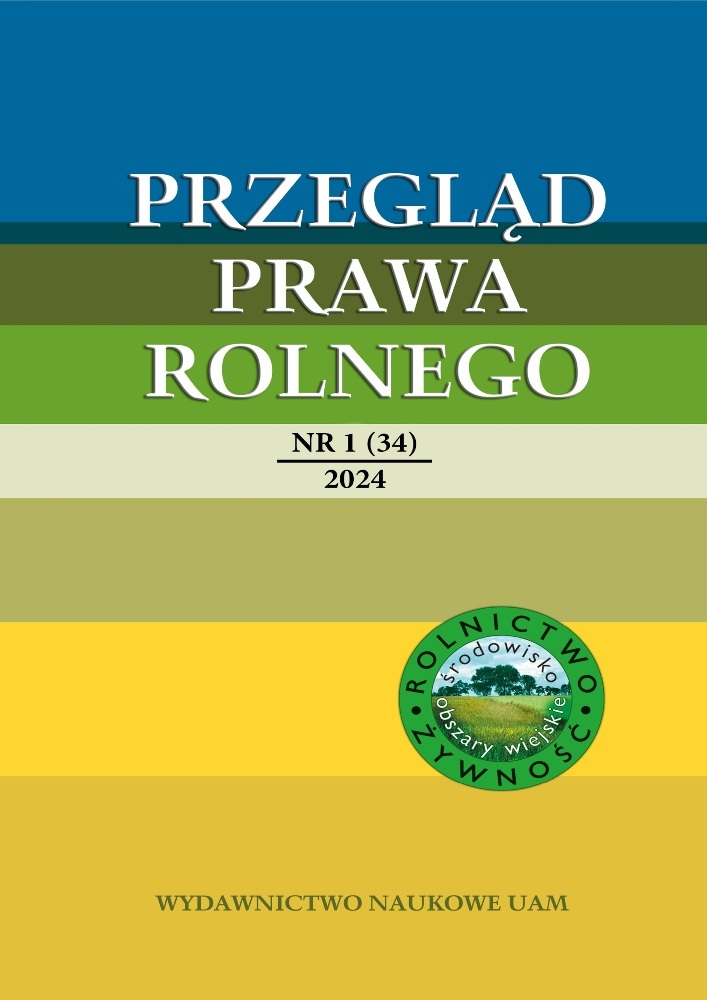Abstract
The aim of the considerations is to determine the legal nature of the payments for areas cultivated with hemp in the light of EU and national law and to formulate an answer to the question whether the legal construction of this payment is in line with the objectives of the Common Agricultural Policy drawn for the period 2023-2027. It has been established that these payments have a conditional character. Indeed, the legislator burdens the agricultural producer with the risk of not receiving any area payments on the area of cultivation of hemp since support is determined by the percentage content of Δ9-tetrahydrocannabinol in the cultivated variety of hemp, which is variable and de facto independent of the farmer. This contradicts the objectives of the CAP, such as promoting fair farm incomes and the resilience of the agricultural sector across the Union, or increasing market orientation and ensuring the competitiveness of farms. The author notes the inconsistency of the Polish regulation of fibre hemp with EU law. It is therefore proposed that the definition of "eligible hectare" in relation to hemp in EU law be clarified, and the EU method for verifying the Δ9-tetrahydrocannabinol content in the Polish legal order in a comprehensive manner be implemented, alongside with the adaptations of the provisions of the Act on Counteracting Drug Addiction to the new conditions.
References
Backer B. de, Debrus B., Lebrun P., Theunis L., Dubois N., Decock L., Verstraete A., Hubert P., Charlier C. (2009), Innovative development and validation of an HPLC/DAD method for the qualitative and quantitative of major cannabinoids in cannabis plant material, „Journal of Chromatography B: Biomedical Sciences and Applications” nr 877. DOI: https://doi.org/10.1016/j.jchromb.2009.11.004
Białousowa J., Bartosik A., Kurhański M., Nagórski A., Tumalewicz B. (1958), Konopie, rośliny włókniste (Fibrous Plants), Warszawa.
Czyżewski A., Stępień S. (2010), Wokół problemu „błędu złożenia” we Wspólnej Polityce Rolnej, „Zeszyty Naukowe SGGW w Warszawie” t. 10, z. 4. DOI: https://doi.org/10.22630/PRS.2010.10.4.43
Gała P. (2022), Admissibility of hemp crop other than fibrous in Poland, „Studia Iuridica” t. 95. DOI: https://doi.org/10.31338/2544-3135.si.2022-95.8
Kaniewski R., Pniewska I., Kubacki A., Strzelczyk M., Chudy M., Oleszak G. (2017), Konopie siewne (Cannabis sativa L.) – wartościowa roślina użytkowa i lecznicza, „Postępy Fizjoterapii” nr 2. DOI: https://doi.org/10.25121/PF.2017.16.2.139
Król M.A. (2015), Nowe rozwiązania prawne w zakresie płatności w ramach systemów wsparcia bezpośredniego, „Studia Iuridica Agraria” t. XIII. DOI: https://doi.org/10.15290/sia.2015.13.05
Kutkowska B. (2009), Wspieranie dochodów rolniczych przez dopłaty bezpośrednie w gospodarstwach Dolnego Śląska, „Journal of Agribusiness and Rural Development” nr 2.
Leśkiewicz K. (2020), Zrównoważone systemy żywnościowe w kontekście reformy Wspólnej Polityki Rolnej – aspekty prawne, „Przegląd Prawa Rolnego” nr 2. DOI: https://doi.org/10.14746/ppr.2020.27.2.4
Łobos-Kotowska D. (2013), Działalność rolnicza jako przesłanka uzyskania uprawnienia do płatności, „Studia Iuridica Agraria” t. XI. DOI: https://doi.org/10.15290/sia.2013.11.04
Łobos-Kotowska D., Bieluk J. (2022), Płatności bezpośrednie, w: P. Czechowski (red.), Prawo rolne, Warszawa.
Łucarz K., Muszyńska A. (2008), Ustawa o przeciwdziałaniu narkomanii. Komentarz, Kraków–Warszawa.
Mackie K. (2007), From active ingredients to the discovery of the targets: the cannabinoid receptors, „Chemistry & Biodiversity” nr 4. DOI: https://doi.org/10.1002/cbdv.200790148
Mańkowska G., Luwańska A., Wielgus K., Bocianowski J. (2015), Ocena zawartości kannabinoidów wybranych odmian konopi Cannabis sativa L., „Biuletyn Instytutu Hodowli i Aklimatyzacji Roślin” nr 277. DOI: https://doi.org/10.37317/biul-2015-0012
Mańkowska G., Strybe M., Chudy M., Luwańska A., Baraniecki P. (2010), Ocena cech użytkowych wybranych odmian konopi Cannabis sativa L. zgromadzonych w Instytucie Włókien Naturalnych i Roślin Zielarskich w 2008 roku, „Zeszyty Problemowe Postępów Nauk Rolniczych” nr 555.
Mechoulam R., Hanus L. (2013), Inne rodzaje kannabinoidów, w: D. Castle, R.M. Murray, D.C. D’Souza (red.), Marihuana i obłęd, Warszawa.
Olkowska O. (2021), Polskie rolnictwo w nowej perspektywie finansowej UE 2021–2027, „INFOS zagadnienia społeczno-gospodarcze” nr 7.
Sadowski J. (2019), Wyciągi z konopi włóknistych na rynku spożywczym w Polsce i Unii Europejskiej, w: D. Łobos-Kotowska (red.), Współczesne problemy prawa rolnego i żywnościowego, Katowice.
Strzelczyk M., Kaniewski R. (2021), Konopie siewne Cannabis sativa L. – jeden z najstarszych gatunków roślin użytkowych, „Borgis – Postępy Fitoterapii” nr 1. DOI: https://doi.org/10.25121/PF.2021.22.1.53
Szymańska E. (2011), Znaczenie płatności bezpośrednich w finansowaniu działalności gospodarstw wyspecjalizowanych w produkcji żywca wieprzowego, „Prace Naukowe Uniwersytetu Ekonomicznego we Wrocławiu” nr 172.
Vyhnánek T., Trojan V., Štiasna K., Presinszká M., Mrkvicová E., Hřivna L., Havel L. (2015), Testing of DNA isolation for the identification of hemp, „Potravinarstvo Slovak Journal of Food Sciences” nr 9. DOI: https://doi.org/10.5219/509
Wielgusz K. (2020), Uprawa konopi włóknistych i oleistych, Brwinów.
Włodarczyk B. (2022), Prawne instrumenty ochrony środowiska i przeciwdziałania zmianom klimatu we Wspólnej Polityce Rolnej na lata 2023–2027, „Przegląd Prawa Rolnego” nr 2. DOI: https://doi.org/10.14746/ppr.2022.31.2.1
License
Copyright (c) 2024 Monika Łata

This work is licensed under a Creative Commons Attribution 4.0 International License.





